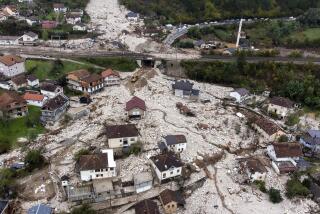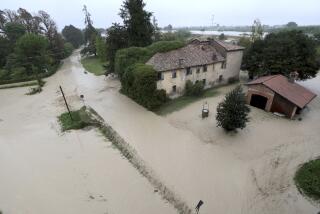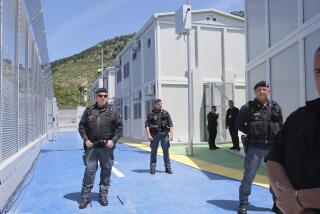Thousands More Kosovars Driven From Province
BLACE, Macedonia — Thousands of Kosovo refugees streamed into Macedonia on Monday, and thousands more waited for daybreak so they too could cross a no man’s land into the country, as Yugoslav forces stepped up efforts to drive ethnic Albanians out of their province.
Officials of the Office of the U.N. High Commissioner for Refugees estimated that 9,000 would cross the border by dawn today. That would bring the total number of refugees entering Macedonia over the past four days close to 20,000--the fastest pace of expulsions since early this month.
Political analysts said that the latest influx, which started Friday, coincides with North Atlantic Treaty Organization bombing runs that have left much of the Yugoslav capital, Belgrade, without electricity and have shut off the water supply for many neighborhoods. They hypothesized that Yugoslav President Slobodan Milosevic is using the uprooting of more Kosovo Albanians to retaliate against NATO.
“NATO is bringing the war closer to every Belgrade resident, so Milosevic is bringing it closer to every Kosovar. . . . It’s sending a message: ‘If you hit me, I’ll hit them,’ ” said a political analyst here who asked that his name not be used.
As the new tide of refugees left Kosovo, a U.N. team that just concluded a tour of the province reported that conditions are “pretty revolting” and called for immediate aid for those living there.
The situation is “worse than what you imagine,” team leader Sergio Vieira de Mello told reporters in Podgorica, the capital of Montenegro. It is the smaller of Yugoslavia’s two republics; the other is Serbia, where Kosovo is located.
In other developments:
* NATO said its latest strikes hit power plants, ammunition dumps and airfields, among other targets. On Sunday, a dozen ethnic Albanian homes in the town of Urosevac were destroyed in a NATO cluster bomb attack that was apparently aimed at a nearby pipe factory.
* The Pentagon announced that the total alliance air armada in the region has grown from an initial force of 350 planes to 1,000--including 723 American aircraft. A Pentagon spokesman said 20 of a group of 24 Marine F/A-18 attack aircraft arrived at Taszar, Hungary, on Saturday. NATO has been eager to move bombers into Hungary to enable the force to attack Yugoslavia from many directions.
* In a fresh instance of political repression in Serbia, four antiwar activists were arrested in the central town of Cacak, according to Montenegrin state television. They will be sentenced by a judge today for “taking part in an unapproved gathering,” the station reported.
* Russia’s special envoy for the Balkans, Viktor S. Chernomyrdin, said he expected progress--specifically, a NATO decision to halt the bombing--during talks this week in Moscow. “A lot has been worked out, a lot of progress has been made, and what is needed now is the final stage,” he said.
Deputy Secretary of State Strobe Talbott is scheduled to arrive in Moscow today for talks with Chernomyrdin and Finnish President Martti Ahtisaari--the third such meeting in recent weeks. After the talks in Moscow, Chernomyrdin plans to travel to Belgrade to meet with Milosevic. Ahtisaari has suggested he may go along if there are signs of progress.
The exodus of refugees over the past few days apparently represented a mix of those who had tried repeatedly to leave the country but were stopped by Serbian soldiers; those who had managed to stay on in their villages despite the state of war and were forced out by the military; and those who heard that the borders were open and decided to take advantage of the loosening to leave.
Some U.N. officials speculated that the Serbs were making a final effort to drive all ethnic Albanians from Kosovo, which Serbs hold to be the historical cradle of their nation.
“You could call it the last push,” said Astrid Van Genderen Stort, a spokeswoman in Macedonia for the U.N. refugee agency. “We don’t know for certain how many people are left in Kosovo, but we’ve seen a massive influx.”
The Macedonian government has been at best unenthusiastic about the continuing flood of refugees because it fears its own ethnic balance could be upset, perhaps resulting in a civil war. Of the 300,000 refugees who have entered Macedonia, a country of about 2 million people, about 60,000 have left for third countries.
Milosevic has appeared to be aware of Macedonia’s vulnerability, and Western officials say privately that he has a tacit agreement with the Macedonian government to keep the flow low. But his forces have continued to push Kosovars over the border.
U.S. officials fear that, as Milosevic becomes more desperate, hundreds of thousands more could flow in and the Macedonian government could become less cooperative.
“They’re tense, but everybody is behaving for now. . . . But thousands more are waiting to come in, and no one knows where it will end,” said a State Department official speaking on condition of anonymity.
Monday night, the refugee registration process, which is handled by Macedonian border guards, was moving at an excruciatingly slow pace, meaning that families who had been traveling for days were left standing for as long as 10 hours waiting to enter the country.
At the start of NATO airstrikes, which began March 24, U.S. military officials said they believed Milosevic had decided to clog the roads out of Kosovo with refugees to stymie what he apparently expected would be an alliance invasion by land.
In Washington, a senior Pentagon war planner insisted that the alliance is not under pressure to begin preparations for a ground war within the next few weeks.
Some NATO officials and many outside analysts have said that, because of the approach of winter and the long lead time needed for a force buildup, NATO would need to make any initial moves toward a ground invasion within the next few weeks.
But Maj. Gen. Charles Wald insisted that “we operate in all kinds of weather conditions.” Some people have made “a little too much of this weather issue,” he said.
De Mello, the U.N. emergency relief coordinator who headed the team that visited Kosovo for three days, said those who remain are “in need of urgent humanitarian assistance.”
“The extent of destruction, burning of houses and shops that clearly belonged to the Kosovo Albanian majority, the number of ghost towns and villages that we visited and the conversations we had with many internally displaced who are still inside Kosovo, I’m afraid confirm what we hear from . . . the refugees who have reached Albania and Macedonia,” De Mello said. “In one word, it’s pretty revolting.”
While the delegation could not determine precise figures, “my guess is that the estimate of anything between half a million and 700,000 still displaced inside Kosovo is accurate,” De Mello said.
“Near Podujevo . . . we met with a group of about 20,000 internally displaced who had nothing, absolutely nothing--no medical assistance, no food supplies, nothing--and who were living on whatever they managed to buy with the very limited amount of money left to them,” De Mello said. “We need to provide them with emergency assistance, not in a week or a month from now, but today.”
De Mello, who is scheduled to meet officials in Belgrade later this week, also criticized the Yugoslav government for blocking the import of humanitarian aid to Montenegro.
In Urosevac, the NATO cluster bomb attack apparently aimed at a pipe factory blew apart roofs and walls and left dozens of small craters in the floors of houses and along the muddy lanes outside. Seven people were injured.
“We were watching TV with the kids, and suddenly there was an explosion,” Saip Lushi, 39, said through a translator. “I thought the TV had blown up.
“I was screaming, ‘Is everyone alive?’ I guess it was just luck that they were.”
Lushi’s son Mohamed, 14, suffered a slight head wound when the ceiling collapsed. He spent Monday morning with two other children picking bits of shrapnel from a small crater in the middle of the living room floor.
Also Sunday, NATO warplanes bombed Dubrava maximum security prison in western Kosovo for the third day; the alliance says the facility’s cellblocks were being used to house soldiers.
Journalists who visited the prison complex for a second time Monday counted the bodies of at least 45 men. Several, but not all, of the corpses left behind had the shaved heads of prisoners; none were dressed in prisoners’ uniforms, but they weren’t in military or police uniforms either.
Inmates at Dubrava hadn’t been required to wear uniforms for well over a year, according to investigating Judge Vladan Bosic.
Prison authorities said Dubrava had about 1,000 inmates, including at least 11 commanders of the ethnic Albanians’ rebel Kosovo Liberation Army. The survivors were moved to other jails or hospitals, Bosic said.
*
Rubin reported from Blace and Holley from Podgorica. Times staff writers Paul Watson in Urosevac, John-Thor Dahlburg in Brussels, Maura Reynolds in Moscow and Paul Richter in Washington contributed to this report.
More to Read
Sign up for Essential California
The most important California stories and recommendations in your inbox every morning.
You may occasionally receive promotional content from the Los Angeles Times.










